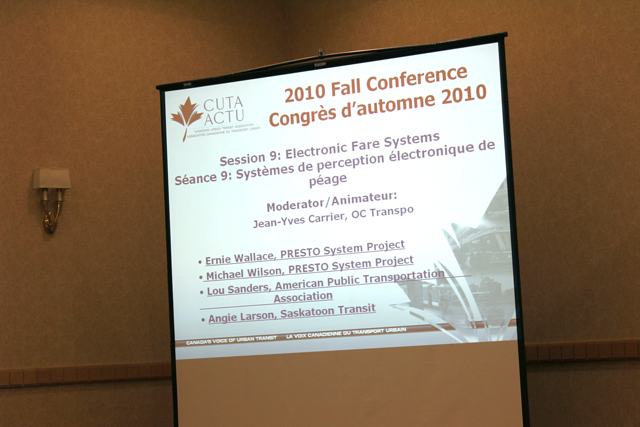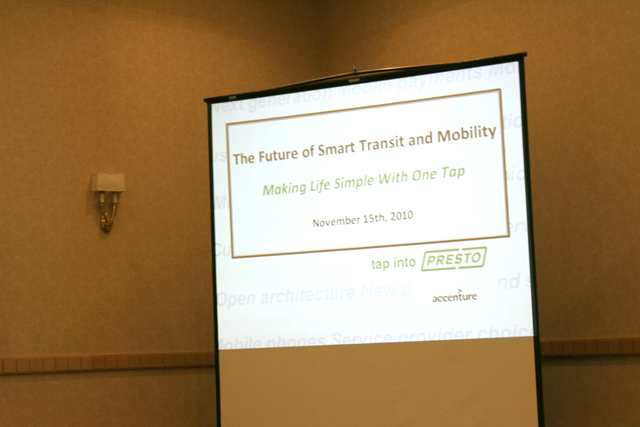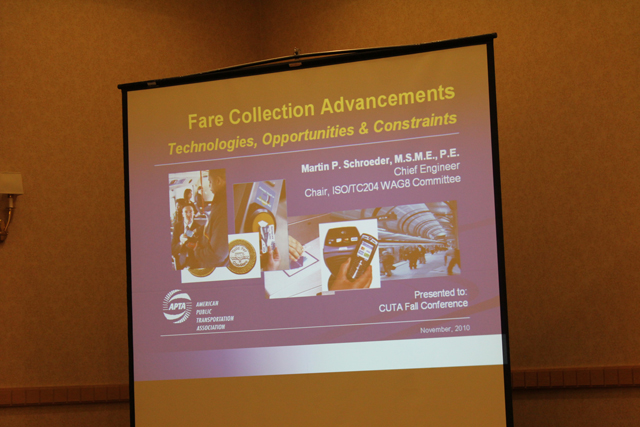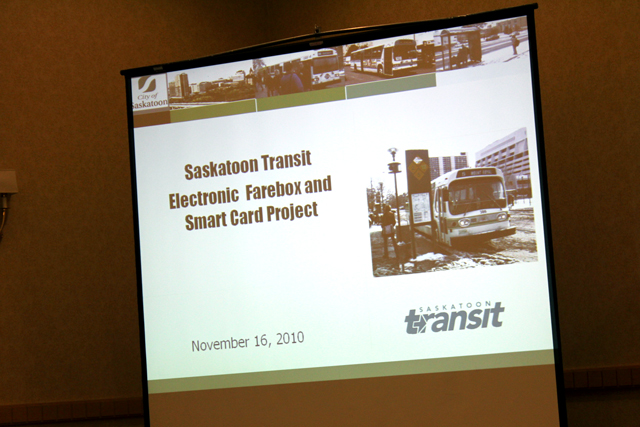CUTA 2010: electronic fare systems session
CUTA 2010: electronic fare systems session

TransLink is hosting the 2010 Canadian Urban Transit Association (CUTA) fall conference this week! See the CUTA 2010 category for more conference coverage.
The conference actually wrapped up yesterday, but I’m still playing catch-up with my posts! On Tuesday I attended the electronic fare systems session, which featured speakers discussing Ontario’s new Presto card, Saskatoon’s new Go-Pass card, and electronic fare system standards. My notes follow — corrections welcome!
Presto: The Future of Smart Transit and Mobility


This presentation was given by Ernie Wallace and Michael Wilson from Accenture, the firm contracted to supply the Presto card in Ontario. They talked about the current Presto rollout and where they see the future of the card and transit payment going. (For those who don’t know, Presto is the electronic fare card that works on 10 systems in Ontario (it doesn’t include Toronto’s TTC). More info here: Presto’s main site, Presto’s Wikipedia page.)
Ernie said that Presto is being rolled out through a low-key launch, with 16,000-17,000 cards in play since mid-May—the current load value of the cards is $5.6 million. He said the e-fare system helps give customers more choice, and allows transit systems to create customized products that target markets beyond monthly passes and other traditional types of fare structures. For example, you could have a specific “football special” that gives you a discount when you tap into a station near the stadium in a certain time period around the game. Which could encourage people to ride to special events!
The next phase envisioned for Presto goes beyond just the purpose-built Presto card—given technology developments and market trends, the cards should be made redundant and you should be able to use your own mobile device to access the system. There should be many different ways to put money on your Presto card, especially through mobile payments, and you should be able to access transit and Presto information from multiple interfaces, any time, anywhere. You should also have a choice of products and service focused on meeting customer demand.
Commercialization of the card was a key aspect. Ernie and Michael talked about how you can drive economic growth and productivity beyond traditional transit revenue. One way would be to leverage the brand as it develops its own value — ie Octopus and Oyster are trusted brands now, so you can use those brands to create more trusted products. You could also help businesses near transit take advantage of the demographic information of customers using stations nearby and market appropriately to them. Other services they thought would be compatible with an electronic fare card included parking payments, loyalty cards, tourist cards. Thinking holistically about the customer and figuring out what would be of additional value to them would also help—for example, if there’s a coffee shop near a station, making it easy for customers to pay for coffee using their e-fares would be a good fit. Also, checking in to attendance at school is apparently one use of the Octopus card!
Information management was another key driver. Michael discussed how information and data gathering could help run services more efficiently—if you know there’s points where there are risks of fare evasion, maybe you can deploy more fare checks there. One slide included the phrase “Today fares are the focus of transit ticketing; tomorrow information management will drive fares, ticketing and much more.”
Toward the end they discussed that the e-fare system needed to move toward an open architecture, to allow people to develop useful software and extensions that could take the e-fare system in new directions. They stressed being conscious of client outcomes and choice, as customer don’t want to be limited into a few types of fare payment or ways to access their information. A product road map is very important, and we need to take advantage of the changing flexibility of new devices. Perhaps an online mobile journey planner of the future will generate the different fare choices and costs for you on the fly, and it can send that information to your device and load it in.
APTA: Fare Collection Advancements and Standards


Lou Sanders, director of services for the American Public Transportation Association (APTA), talked about APTA’s efforts to generate common standards for electronic fare system services.
Lots of it was a bit technical and thus over my head, but I caught that the point of standards was to help agencies have greater control and flexibility over fare collection systems and allow regional partnerships, plus integration with intelligent data systems people might be developing.
Lou stressed that the future of applications in transit is in mobile devices—allowing online, real-time interactivity for customers, and using customers’ infrastructure to power applications. Changes in credit and debit payment processes have allowed mobile apps to accept these kinds of financial transactions, and allows them to be carrier agnostic.
He also mentioned that the work on standards for mobile payments and more can be found on APTA’s standards website.
Saskatoon Transit: Electronic Farebox and Smartcard Project


Angie Larson from Saskatoon Transit discussed implementing a smartcard system at a small-to-medium agency: Saskatoon Transit serves about 223,000 residents with 140 conventional and 24 accessible buses.
There were three goals for the program: collect accurate ridership info with location, time, and demographics, automate the transfer system, and streamline revenue collection processes. And this program was spurred on because their antiquated fareboxes needed replacement—no more parts were being built for them any more! Smartcard readers were installed in all buses and 60 vendors were trained and given new technologies to allow smartcard sales. It took about a year to plan the program and develop an RFP (April 2008-2009), and then another year to get implementation ready (May 2009-February 2010).
The Go-Pass system eventually launched in February 2010, and for five months, the old and new fareboxes were on buses side by side, before the old ones were finally phased out. Accessible buses received handheld readers instead of new fareboxes, because passengers with mobility issues may not be able to reach the front of the bus and swipe in. There are two types of tickets—a permanent plastic card and a disposable cardboard version for short-term tickets. U-Passes were handled through a sticker on student cards—the sticker had a microchip and antenna in it. Stickers are time based, and last for one semester: after that students can get their stickers “reloaded” for another semester, so they don’t have to discard stickers every semester.
There were challenges, of course. At the beginning of implementation, boarding times were slower, though they have now sped up. Reading times for the cards were also not as quick as expected but it has been improved through work with the manufacturer. The number of cards needing replacement has gotten costly—Saskatoon does not charge for its cards, though other cities do, and they surmise that this may give people less reason to hang onto the card as something valuable. Card vendors have high staff turnover and need continual training. And on and on.
However, there are opportunities: they will be allowing online card reloading before the end of the year, they’re trying a vending machine out so customers can buy cards on their own, and they can try out a new fare structure (for example, a monthly pass doesn’t necessarily have to start at the beginning of the month). And adding other corporate facilities to the card might be useful, like access to local leisure centres and the like.
Questions!
Some of the questions asked included:
Q. How do you ensure my information is secure if I’m paying through a mobile phone?
Ernie: There are multiple levels of security on mobile payments, and encryption is getting better. The assumption is that technology can provide that protection.
Lou: Standards are also being developed around privacy.
Q: Presto has about 16,000+ cards on the system when there are more than a million riders in the Toronto area. When does Presto expect to fully take over the market in the Toronto area?
Ernie: We made a choice to do no push marketing, it would be exclusively a customer pull for the card. Then once the expansion is done in the 905 area, a campaign will start to ask people to trade in their tickets. In three years it will eventually be 1.5 million cards on the system. Other places started in a different way—they printed hundreds of thousands of cars for the launch, but that’s not the strategy with Presto. Two factors drive adoption: 1, an economic advantage to using the card, and 2, removal of the existing fare media. That was the experience in the Madrid system. But people purely on convenience factors want the card. Currently our online orders exceed the present supply.
Q: Are there any estimates of new ridership driven by the card itself, or what net revenue might be expected?
Ernie: A nice easy question. There’s no empirical data but San Diego’s system thought there might have been a 3-5 per cent increase in ridership based on the convenience factor alone. People don’t want to line up to buy their passes every month, they want to buy it now.
Jean Yves Carrier (moderator from Ottawa’s transit agency): there is a big business case too, in that we print a lot of paper tickets, and there is convenience of having all products on one card.
Angie: The personalized card is an advantage. All the information is in the system, so if you lose your card we can reissue it with the value intact. Parents love this.
Q: For Angie: with the U-Pass sticker, how do you verify the eligibility of the student?
Angie: Administration is left up to the university to manage and distribute.






Actually, when I was in Toronto, I noticed some TTC stations had PRESTO card readers, but not all of them. And according to PRESTO’s website, the TTC is a participant of the program.
ericmk: Hmm… I’m not quite sure! There were a number of stories in the last little while about the TTC struggling with whether to adopt Presto or not and I don’t remember hearing a resolution to that. The Wikipedia page mentions that the card readers are a test case. Can somebody from Toronto or the TTC perhaps set us straight?
[…] This post was mentioned on Twitter by Breaking News in Van, iSkytrain. iSkytrain said: CUTA 2010: electronic fare systems session http://ff.im/-u02Yx […]
It sounds like the transit operators know what users own which cards (so cards can be replaced, and demographic data can be collected). In other words, they can track where and when specific people ride. Isn’t this a privacy concern?
Privacy is important, but at the same time, by automating data collection on when and what routes I travel on…. it really provides an accurate means of seeing where demand is highest and where expansion should be spent.
It wasn’t long ago when the 98 BLine, and later the Canada Line, would be predicted as a complete failure. Unlike Expo and Millenium, the Richmond services was packed standing room only since the first days of operation.
The Richmond service gave operators a clear picture that travel patterns should be focused on the downtown core.
Typo…
The Richmond service gave operators a clear picture that travel patterns should NOT be focused on the downtown core.
The Canada Line to Richmond should have been the first Skytrain line, but all the “not in my backyard” that was going on stalled it and the Expo line was built instead.
The idea that all travel leads to downtown Vancouver is an old one, and the reason that there hasn’t been much of a transit grid anywhere else. I grew up in N Delta and the only time I could visit my grandmother in Richmond was when my parents drove there – taking transit meant a 2-3 hour trip each way. Even now bus service between the two areas is pretty minimal.
I don’t mind if they code electronic fare cards, but I don’t like the idea of it having all my info on it and someone can track where and when I travel.
If it’s a like the cards in Hong Kong…. there is no personal information on the card. Labelled as an “electronic wallet”, it’s just a means of paying for your fares and expenses.
Yes it would show someone used the card get on at one point and get off at another. But there is no address of my origin or destination, just a general area of where the bus stops are located.
If I refilled the card with “cash” at a dealer, there is no means of personal information tracked. If you choose to load the card automatically from a bank account or credit card, yes there could be a means of linking your personal information to its usage.
Jhenifer, I live in Toronto and I can confirm that Presto card readers have been installed at selected TTC subway stations. These are permanent installations – they are not test cases – and the TTC has committed to them. See the rollout page on the Presto website: https://www.prestocard.ca/en/StaticContent/Faq/#rollout
The debate in the City of Toronto over open fare payment vs. Presto is related to the rest of the TTC system. The TTC has already issued a RFP to 3 short-listed vendors to provide the equipment.
Hope this helps.
Jason: just to elaborate on your concerns about privacy a bit. As an organization funded by public money, we are bound by some pretty strict provincial privacy laws as to what we are permitted to collect from you, where such data can be stored, what can be done with it, etc. I don’t know about the specific implementation of the card (we haven’t yet selected a supplier so we don’t have those details) but your private information is of great concern to us! Based on our past work, I would suspect that just a larger, anonymous snapshot of people’s travel patterns would be available to us as employees to enable us to plan the system intelligently. And I guess if you are still concerned about privacy, there will always be cash fares!
That is very attention-grabbing, You are an excessively professional blogger.
I’ve joined your feed and look forward to looking for extra of your excellent post.
Additionally, I’ve shared your site in my social
networks
I have been surfing online more than 4 hours today, yet I never found any interesting article like yours.
It is pretty worth enough for me. Personally, if all web owners and bloggers made good content as you did,
the internet will be much more useful than ever before.
This session on electronic fare systems at CUTA 2010 was incredibly insightful! The presentations highlighted the innovative strides being made in transit fare technology, from Ontario’s Presto card to Saskatoon’s Go-Pass system. Ernie Wallace and Michael Wilson’s discussion on Presto’s future, including mobile device integration and economic benefits, was particularly engaging. I also appreciated Lou Sanders’ emphasis on standardization and mobile advancements by APTA. Saskatoon Transit’s Go-Pass rollout demonstrated practical challenges and opportunities, offering valuable lessons for other agencies. The Q&A session addressed key concerns like security and adoption rates, providing a well-rounded view of the evolving landscape of electronic fare systems. Great coverage and a fascinating look at the future of transit payments! 🚍💳 iqratechnology